Hamburger SV currently sits on top of the Frauen Bundesliga 2. However, that is a stark contrast to the last decade for the North German side.
With the side established in 1970, they enjoyed relative levels of success and were a mainstay in the Frauen Bundesliga between 2002 and 2012. However, in 2012, the club decided to announce the disestablishment of the first team, and in 2013, the reverse side was placed in the German Regionalliga Nord division.
However, you might expect that a club with its resources will just bounce back, right? No. After four seasons in the division, they were facing relegation from this division. Their fortunes only began to change in the 2018-19 season as they were promoted into the regionalliga. After another four seasons in the division, where they faced back-to-back promotion playoffs, they finally reached the Frauen Bundesliga 2.
Following promotion, they have started this season in red-hot form and currently sit top of the league at the mid-way point. With the side close to back-to-back promotions and looking to return to Germany’s top flight for the first time in over a decade, we chose to provide an analysis of them in more detail for this tactical analysis. In this scout report, we will break down some key statistics and tactics that have helped Hamburger have success so far this season.
Outlining attacking play using data
The first thing to look at is the in-possession principles that underpin Hamburger’s success so far this season. The first thing to look at is attacking productivity.
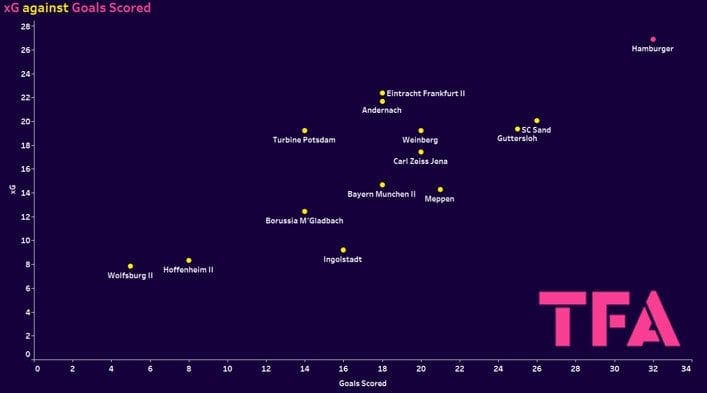
This first graph details the xG against goals scored so far this season. We did this to demonstrate how Hamburger has created the most goal-scoring opportunities so far this season. We also used this graph to illustrate that they not only create the most chances but also convert the most chances, with them actually exceeding their xG of 26.88 by 5.12 goals, scoring 32 goals so far this season, with Hamburger leading the division in both categories.
Ok, so having provided some baseline attacking stats, let’s look at some more data which might help to provide additional context to help explain this attacking proficiency. This graph illustrates the relationship between key passes and touches in the box. The reason we chose these two variables is that the more key passes you are able to execute, the more goal-scoring chances you are able to create. We also picked touches in the box as a second variable, as this will help to indicate the quality and danger of those key passes, with the expected threat of possession in the box being considerably higher than that by the halfway line, for example.
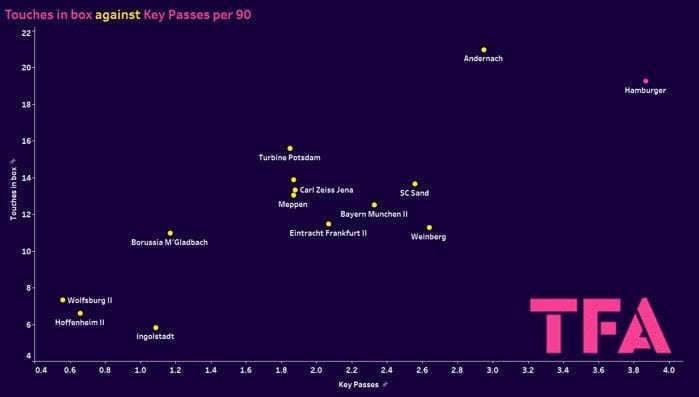
This graph illustrates that Hamburger are a leading side in both these aspects of the game. With an average number of key passes per 90 at 3.78, leading the division to the next best 0.92 key passes worse off. Then, in terms of touches in the box per 90, they are second in the division with 19.26, only bettered off by Andernach on 20.97.
Now, having briefly looked at some aspects that may indicate why Hamburger have had success. We are going to look at how Hamburger has played throughout the season. One of the most notable aspects of their game is the balanced approach they have to attacking play, with them not committing to a fast-paced possession style of football nor a more direct or counterattack style of play.
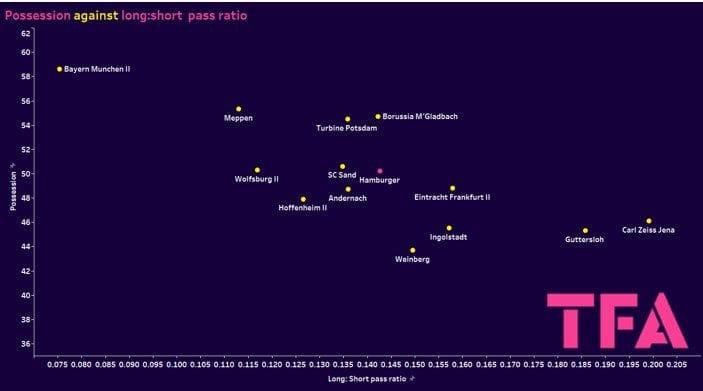
This graph helps illustrate the balanced style of play we were talking about. This graph compares the long: short pass ratio with the average possession per game. The implication is that a high long: short pass ratio suggests a more direct and long ball style of play, while a high possession count suggests a commitment to a more positional play-based style.
However, as you can see, Hamburg is pretty middle of the row in both aspects, with them averaging 50.2% possession, which puts them in seventh place in the division. Then in terms of the long: short pass ratio, they completed 0.14 long passes for every pass they completed in the division, which puts them again in seventh place in the division, so around the middle of the pack.
Now, all this goes to illustrate the balanced approach they have to the game, with the ability to alter their style of play to be specific to their opponents. For example, Bayern Munich II led the way in terms of playing a high possession style of play, helped by their abundance of technically proficient young players. In contrast, Carl Zeiss Jena deployed a more direct style of play, completing over two and a half more long passes per short pass than Bayern II.
Balanced attacking style of play
Now, having provided some context as to how they are a balanced team in attack, let’s provide some tactical details.
The first aspect we are going to look at is their shape in possession. They generally operate with a 4-1-4-1 shape in possession, with midfielder Svea Stoldt either dropping deep as the sole pivot; alternatively, they can drop two midfielders or playing with two midfielders who play as double pivots, while the two centre backs spread wide. Within this, generally, what they look to do is play around the opposition shape and get the ball down the flank.
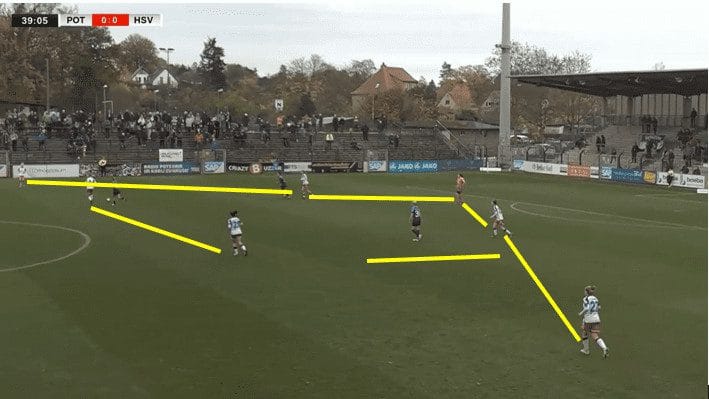
In this above example against Turbine Potsdam, you can see how Hamburger deployed a double pivot with Svea Stoldt and Pauline Machtens dropping deep as the two pivots. Note how the centre-backs have parted, allowing the goalkeeper to step up and support the attack from the middle. In this case, she is able to play a line-breaking pass to Stoldt. With Stoldt already being wider, the numerical superiority is already there, and they are able to progress the ball down the flank quickly.
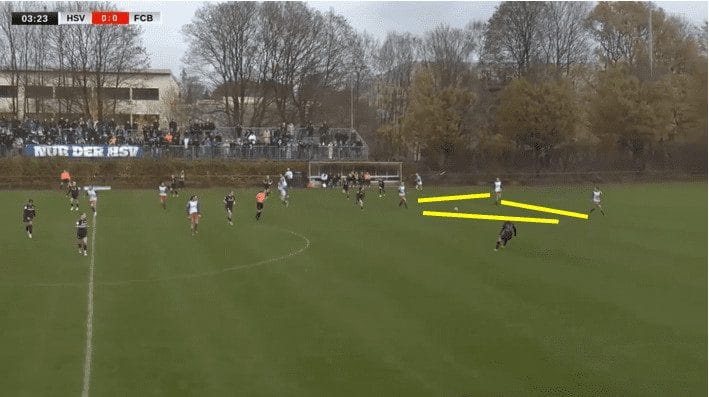
In this situation, they are playing against a dangerous Bayern II side, and as such, what instantly stands out is the difference in attacking shape, with Stoldt being the sole pivot option; the other thing to note is the lack of width in comparison to the previous example with Hamburger looking to keep things considerably tighter due to the attacking threat that Bayern possess.
One of the primary reasons for trying to isolate the ball down the flanks is their strength; the forwards, particularly the wide players, have to carry the ball forward and progress attacks with the ball at their feet.
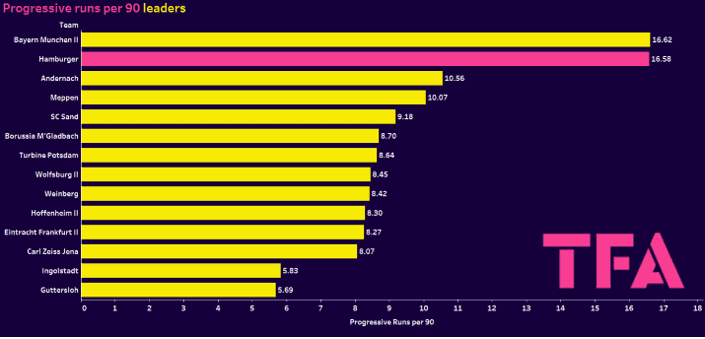
This table here illustrates that point nicely with Hamburger and Bayern II leading the way significantly over the rest of the division. When you break down that 16.58 progressive runs per 90, the prominent names that crop up are left winger Lisa Baum, 3.15 progressive runs per 90, right winger Melina Krüger, 2.38 progressive runs per 90, centre forward Carla Schulz, 2.38 progressive runs per 90. As you can see, these three players make a significant bulk of the progressive runs per 90, and actually, all three players are in the top twelve performers in the division.
Then, with the ball being driven down the wings, the next task for the side would be how to get the ball into goalscoring positions, and one of the major ways that they do this is by getting behind the defence in the wide areas, which gives them the time to play low whipped crosses across the box creating significant high-quality goal scoring opportunities.
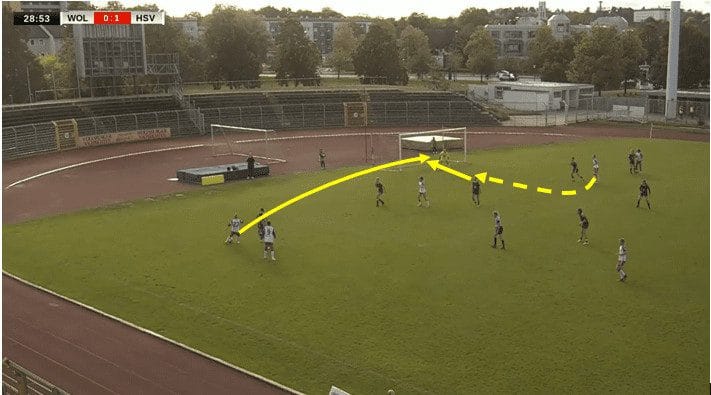
Here, what you can see is the ability that Hamburger have to provide numerical superiority down the flank to create a two-against-one scenario where Sara Stöckmann is able to create the space to play a low left-footed cross along the box for Dana Marquardt to run onto and tap home in the middle.
Then comes the more direct style of play with the focus still on playing the ball down the flanks but with a larger emphasis on using speed in behind to target this aspect.
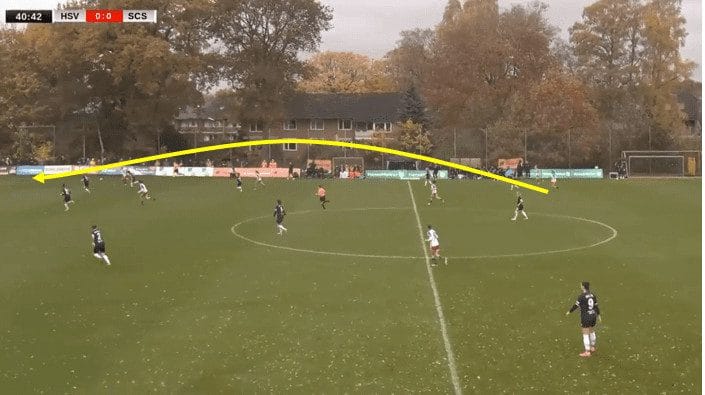
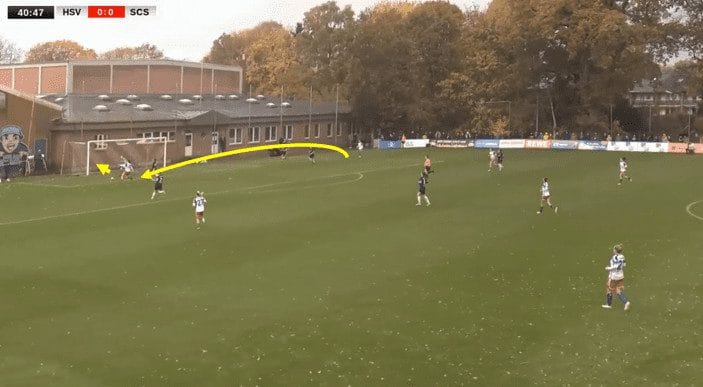
Here, in this example, what you have is right central defender Marlene Deyß playing a long forward ball over the top for the right winger on the day, which was Schulz. She played a right-footed ball behind the opposition’s defensive line, which resulted in a tap-in for Larissa Mühlhaus on the back post.
Out of possession
Here, we are going to outline Hamburger’s defensive output, and again, one of Hamburger’s greatest assets is their ability to be adaptable and diverse, utilising a more balanced approach to the game.
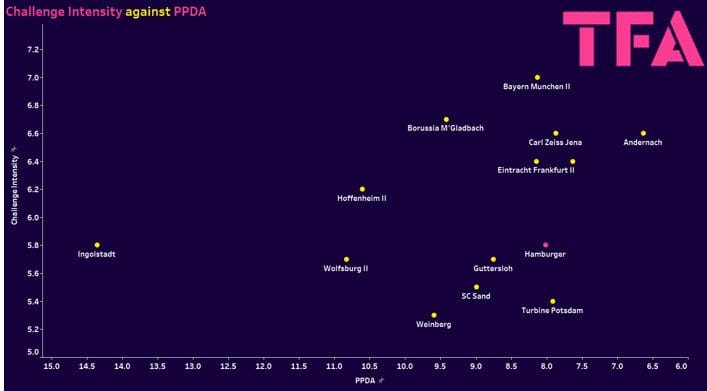
This graph plots the PPDA (pressures per defensive action) against the challenge intensity. The axis for PPDA has been reversed as a low PPDA indicates a higher level of pressure, so we flipped it to illustrate the pressing sides in the division. The implication is that a high challenge intensity, number of duels, tackles or interceptions in every minute of possession, and a high PPDA would indicate a strong pressing side that plays with a lot of aggressive intensity and looks to win the ball back quickly.
However, that doesn’t apply to Hamburger, who again sits relatively in the middle of the row with a PPDA of 8.01, which puts them in fifth place in the division. Then, regarding challenge intensity, they have a rate of 5.8, which puts them in sixth place. So, although in the top half of both categories, they are by no means clearly leaning in one direction.
So if they are not a high-pressing team but they equally aren’t a low-block side, what are they? Well, what they are is an organised team who will look to create a circle that encloses the midfield area and manipulates the opposition into playing down one side of the field; they do this by asking the two wide players to play more advanced than the rest of the midfield shape additionally they will put aggressive backside pressure on the opposition forcing them to go back the other way.
In addition, they again demonstrated the flexibility to play a three-person midfield, with Svea often playing deeper than the rest of the midfield as a screen in front of the back line. Alternatively, they have played a midfield two and played in a 4-4-2 type shape.
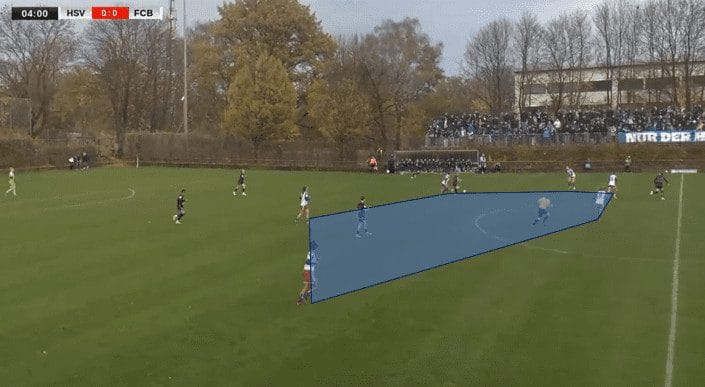
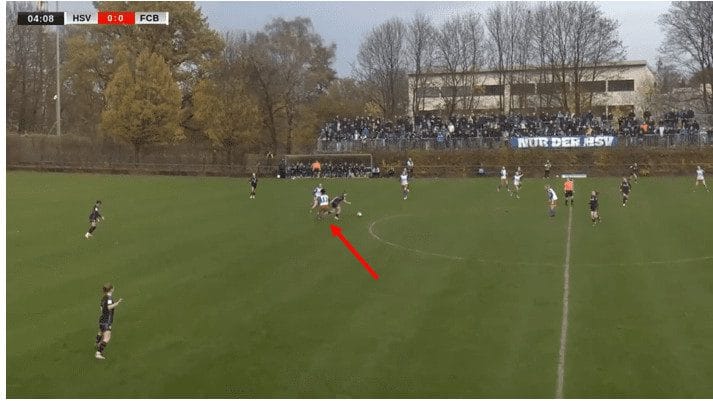
Here, you can see how they look to enclose the central area, with both wingers playing more advanced than the two central midfielders. Then as the ball is played towards the midfield the left winger, Baum, puts back side pressure on the Bayern player this forces her to turn away and into the midfield area where Hamburger have players blocking passing lanes. Thus manipulating Bayern to attack down their left flank and being able to control them despite still defending.
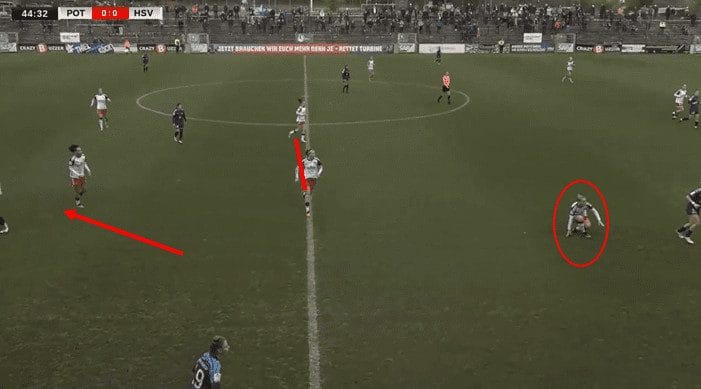
In this example, against Potsdam, they are playing with that midfield three, with Stoldt playing as that screen in front of the backline. Additionally, instead of having the front two, the ball-side winger will step up to press the defender if engaged.
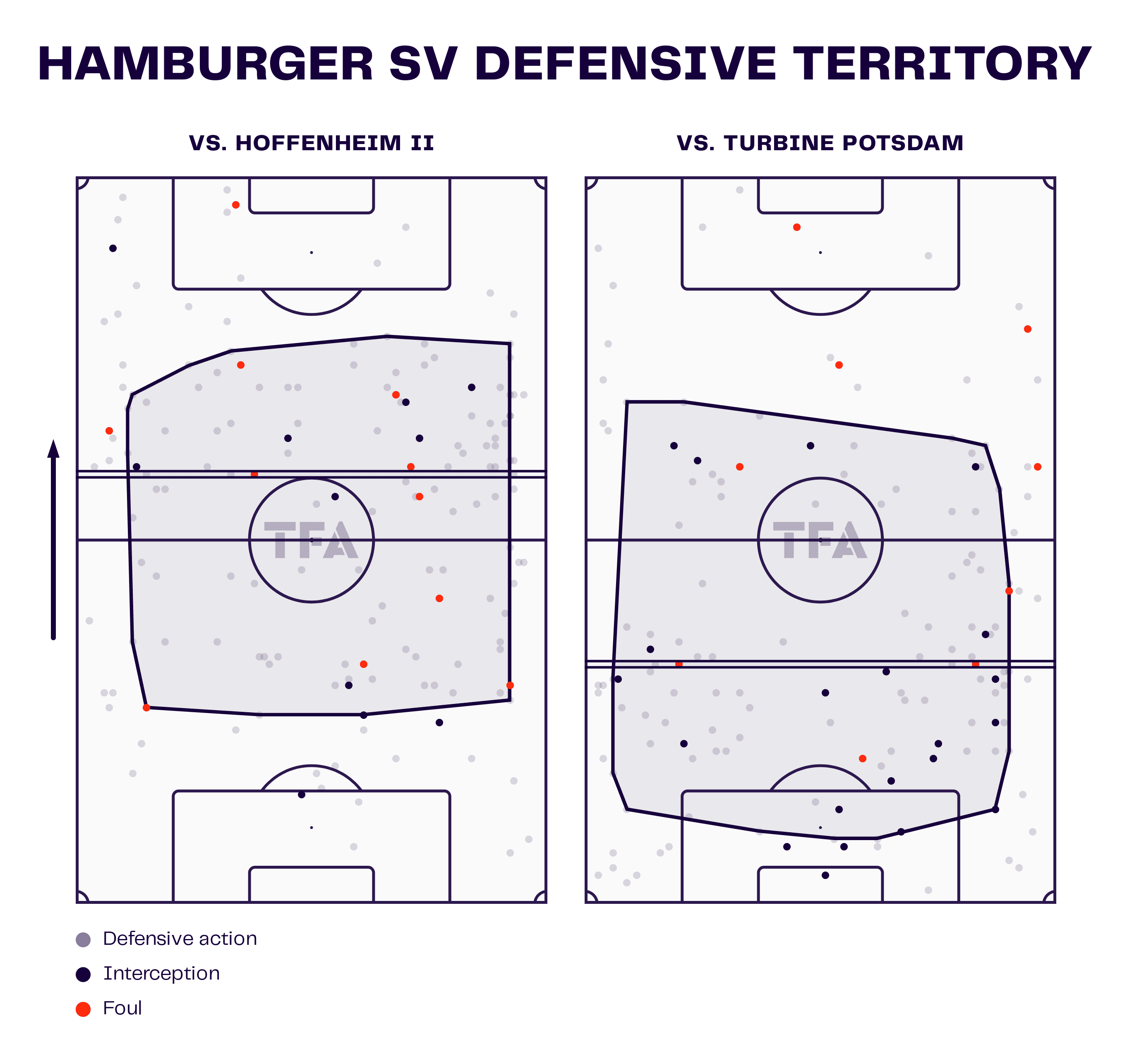
This diagram further illustrates the versatility that Hamburger possesses in defensive strategies. In the game against Hoffenheim II, they looked to dominate the field position and regain the ball high up the field. In the game against Turbine Potsdam, they generally sat deeper, looked disciplined in their shape, and waited for opportunities or mistakes where they could pounce and regain possession.
Just a few things to notice that highlight this point: the average defensive line against Hoffenheim II is so advanced that it’s actually in the opposition half of the field, whereas against Turbine, it’s significantly deeper mid-way into their own half. A second aspect to look at is the fact that the number of defensive actions high up the field is considerably higher against Hoffenheim than against Potsdam, further demonstrating the different styles of play.
Set piece struggles
Now, one of the aspects that Hamburger noticeably struggled with was defending set pieces, which has a large amount to do with why Hamburger has conceded 9.28 more goals than their xG against 7.72 would suggest. Here, we will outline a few key examples of where they have made mistakes in this area.
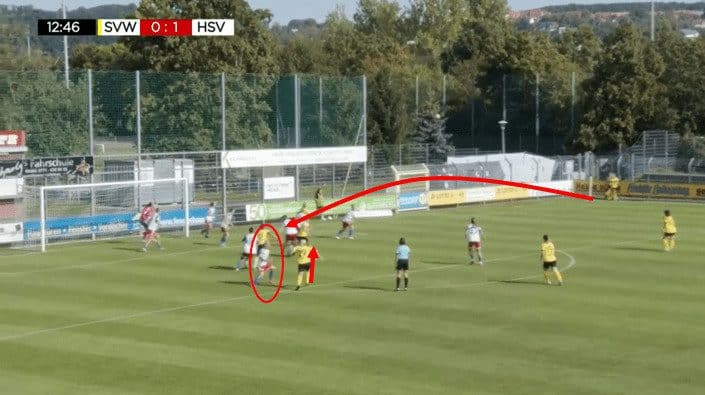
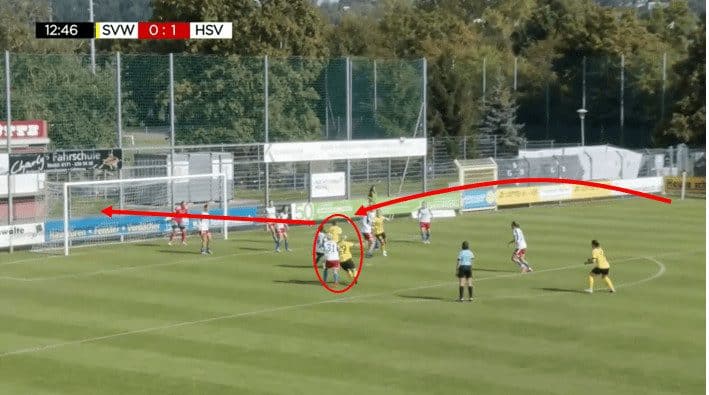
In this instance, Weinberg plays a clipped lofted ball into the box. What happens is the Weinberg player starts to make a run from the edge of the box towards the penalty spot. The problem comes with how right-back Jobina Lahr makes her hips square, which limits her ability to move backwards and gives her opponent the jump on her, resulting in a goal being headed in.
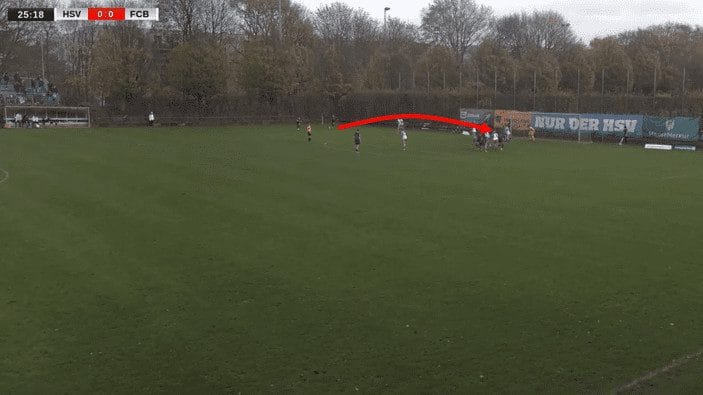
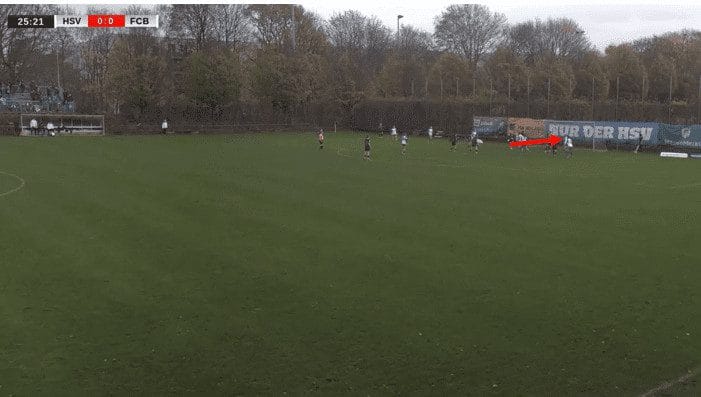
In this example, opponents Bayern II have a wide freekick. Hamburger actually deals with the first ball, but the issue lies in the second wave, with all eleven players just standing still and watching as the ball is in the air for about half a second, and they all fail to react to the ball.
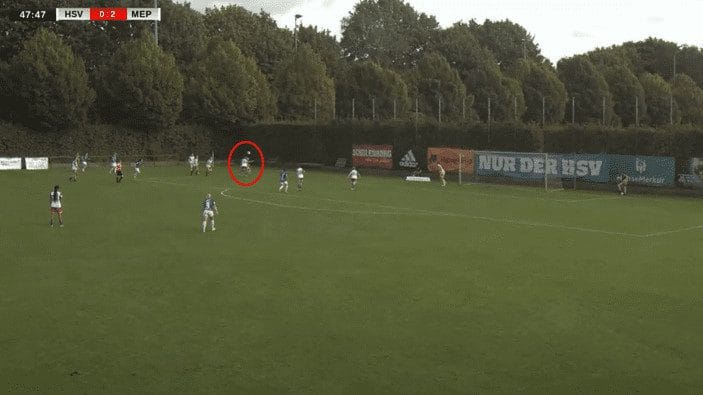
This example comes from a throw-in, but again, the defensive shape lets down the Hamburger side. With central defender Emilia Hirche allowing the forward to roll her and get in behind her, this results in a goal for the Meppen forward. What should have happened is she put pressure on the Meppen player from the goalside and prevented her from turning and having a clear path to the goal.
These aspects are not overly challenging to rectify, but these small details could be the difference when it comes down to the end of the season.
Conclusion
As we have outlined in this tactical analysis, Hamburger are a fascinating side with a very balanced approach to the game, enabling them to be division leaders in attacking production. The side is currently in pole position to be promoted back to the Frauen-Bundesliga.
What is most interesting to me about this Hamburger side is the young age of many of the key performers in the Hamburger side, with both wingers Baum and Krüger, along with midfielder Stoldt, all being eighteen or younger. This will only hold the side in good stead as they are only going to improve with their prime production years still ahead of them.






Comments